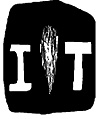 Published as “Mini SF* game” by Dave Casciano Co., 1978
Published as “Mini SF* game” by Dave Casciano Co., 1978
Designed by David Casciano
The cover artwork is not exactly as illustrated, but is near enough to damn it.
Period: Science Fiction future
Time scale: unknown
Space scale: unknown
Unit scale Individual vehicle to small group
Components
1 5" x 7" wretched flimsy cardboard box
1 8-page rules booklet, smearily printed on nasty yellow paper
1 10x16" hex map of a desolate area around a planetary defense base printed in black on cream coloured cardstock
1 sheet of 32 1/2" diecut counters
Counter Manifest
32 total, all black on pumpkin. The artwork is quite crude.
3 Heavy Lazers [sic]
3 Light Lazers
3 Heavy CPS
3 Light CPS
2 Shrike missiles
1 Thrike missiles
2 Tholt missiles
1 Zap missile
6 light projectile tubes
4 medium projectile tubes
2 heavy projectile tubes
2 ITs
The Publisher Says
“IT is a Mini SF* game that you play by yourself or with one or two other people. It is fast, fun to play, and always exciting. The game is always different each time you play with four scenarios you can use depending on how much time you have and how many people are playing ... IT is the game where you design the monsterous (sic) “IT” war machine yourself; then try to take a planet with it ... (* Trade mark for the Micro Science Fiction Games of Attack International, the creators of modern S.F. Wargaming, and the first to create Mini SF* games.)”
The Reviewer Says
Well, I couldn’t actually find a review of this game, but there apparently is a capsule review in Space Gamer 35.
According to Boone, Casciano was responsible for ten wargames, all of them published by Attack International Wargaming Association, which produced 15 games in all (Simulacrum database lists a possible 16th -ed). Most of them, at one time or another, have come in for a critical shellacking.
Comments
This is a crude, unplayable and obvious ripoff of Steve Jackson’s game Ogre, which was released in the previous year. Last issue, Joe Scoleri reviewed a small game called Hyper Battle and, in the name of the greater good, sounded a warning that that particular turkey was only for the morbidly curious. Ditto for this one.
Dave Casciano’s games were renowned among players for their murky map and counter artwork, bizarre time and space relationships, and remarkably opaque or just plain incomplete rules featuring a childish orthography (for example, in the rules of IT the word integrity is rendered as either integerty or integerity). IT is no exception to the rule, although its small size means there’s considerably less of it to plow through.
If I didn’t know otherwise, I would think this game was the product of the mind of an enthusiastic but distractible 12-year-old.
I guess one might call Dave Casciano the Ed Wood of wargaming, but only if the Bulldada factor in his games were high enough (to use a concept from the Church of the SubGenius -- Bulldada is crudely defined as “an unnamable property embodied within certain mundane objects which, despite a surface appearance of utter worthlessness, broadcast garishly illuminated gnosis and bombastic moral lessons, offering a veritable Satori of Stupidity to those in The No”). It certainly isn’t in this one.
Collector’s Note
Production figures for Dave Casciano’s games are not available but could not have been high. The games are only rarely seen for sale or auction. Boone lists low, high and average prices of 4/8/6.00 at auction and 4/30/ 17.00 for sale.
Other games on this subject
Besides Ogre, two other SciFi/ fantasy games where one side has one big unit include Stomp! (one giant vs. some little people, Chaosium 1978) and the Creature That Ate Sheboygan (movie monster attacks a city, SPI 1979).
Other games by this designer
7th Cavalry; Arms Race; Balance of Power; Combat Moonbase; Formalhaut II; Operacao Littorio; Star Raider; Victory at Sea; and War of the Star Slavers.
Back to Simulacrum Vol. 4 No. 1 Table of Contents
Back to Simulacrum List of Issues
Back to MagWeb Master Magazine List
© Copyright 2001 by Steambubble Graphics
This article appears in MagWeb (Magazine Web) on the Internet World Wide Web. Other articles from military history and related magazines are available at http://www.magweb.com